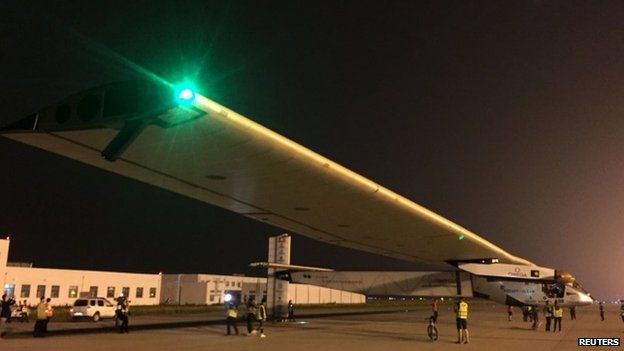Solar Impulse to land in Japan because of poor weather
- Published

A record-breaking attempt to cross the Pacific Ocean using a solar-powered plane has been aborted.
Poor weather conditions are forcing the Solar Impulse craft to head to Japan to land.
The pilot was 36 hours into what was expected to be a six-day journey from China to Hawaii.
The team will now wait in Japan for clearer skies before attempting to continue.
Swiss pilot Andre Borschberg, who is flying solo, tweeted that he was disappointed but looking forward to the next attempt.
Solar Impulse 2 forced to land in Japan
Project co-founder Bertrand Piccard, who has been watching the flight from mission control, in Monaco, said: "We are not daredevils, we are explorers.
"We have to put safety at the top of all of our priorities.
"Everyone is very happy with the plane - but the weather does not fit.
"We land in Nagoya and we wait for better conditions to continue."
Bertrand Piccard: "If it was easy someone else would have done it before"
The plane should arrive at the Komaki airfield in Nagoya at approximately 23:00 local time (14:00 GMT) and its progress can be tracked on the Solar Impulse website.
A spokesperson for the team said the batteries were currently fully charged.
This is the seventh leg in an attempt to circumnavigate the globe using just the energy of the Sun.
LEG 1: 9 March. Abu Dhabi (UAE) to Muscat (Oman) - 441km; in 13 hours and 1 minute
LEG 2: 10 March. Muscat (Oman) to Ahmedabad (India) - 1,468km; in 15 hours and 20 minutes
LEG 3: 18 March. Ahmedabad (India) to Varanasi (India) - 1,215km; in 13 hours and 15 minutes
LEG 4: 19 March. Varanasi (India) to Mandalay (Myanmar) - 1,398km; in 13 hours and 29 minutes
LEG 5: 29 March. Mandalay (Myanmar) to Chongqing (China) - 1,459km; in 20 hours and 29 minutes
LEG 6: 21 April. Chongqing (China) to Nanjing China - 1,241km; in 17 hours and 22 minutes
LEG 7: 31 May. Nanjing (China) to Kalaeloa, Hawaii (USA) - 8,200km; journey aborted, plane diverted to Nagoya, Japan
The experimental craft, which is covered in 17,000 solar cells, took off from Abu Dhabi in March.
The Pacific crossing, however, was always going to be the most challenging part of this epic journey.
Solar Impulse had already waited more than a month in Nanjing for the right weather conditions to open up over the Pacific.
It needs not only favourable winds to push forward, but also cloud-free skies during the day to soak up enough energy from the Sun to enable nighttime flying on its batteries.
The team's meteorologists thought they had identified a suitable weather window - and the plane set off at 18:39 GMT on Saturday.
Mr Borschberg had been making good progress. However, in the early hours of Monday morning (GMT), the Solar Impulse team announced it was putting the plane in a holding pattern.
BBC weatherman Pete Gibbs explains the meteorological barrier facing Solar Impulse
The pilot was asked to circle over the Sea of Japan while meteorologists assessed whether they could find their way through a worsening weather front close to Hawaii.
Mr Borschberg was just hours away from the point of no return - the stage in the flight where, if something were to go wrong, the plane would be too far from land to turn back and Mr Borschberg would have to bail out into the ocean.
The team decided this was not a risk worth taking.
By the time the craft lands, it will have flown more than 3,000km (1,860 miles) in about 40 hours, which is already the longest flight ever made by a solar-powered airplane in terms of both duration and distance.
While Mr Borschberg waits in Japan, his support team will try to identify another weather window to get to kalaeloa airport in Hawaii.
However, the fear is that further delays could have an impact on later stages of the round-the-world quest.
Ideally, the team needs to cross America, and then the Atlantic, before the hurricane season starts to peak in August.
Follow Rebecca on Twitter.
- Published30 May 2015
- Published13 May 2015
- Published25 May 2015